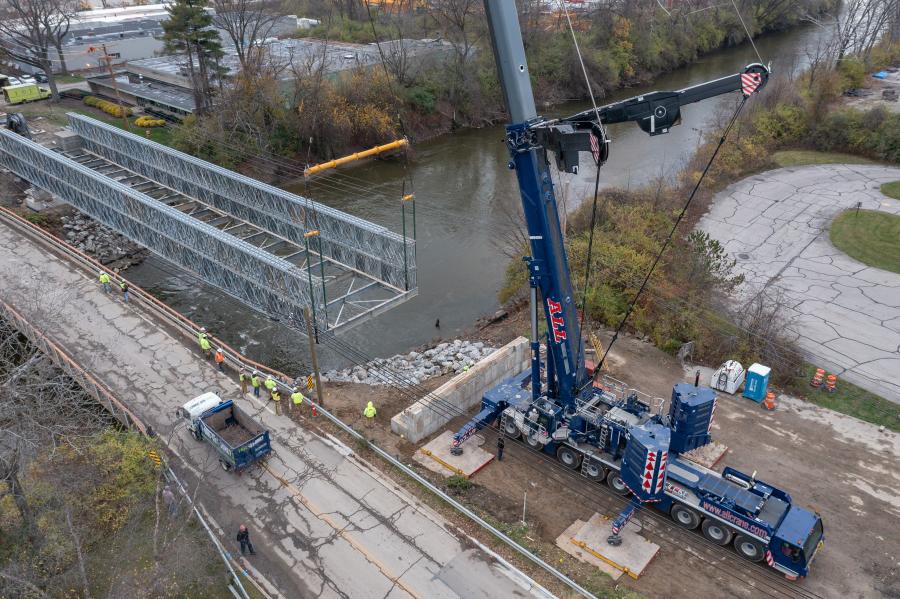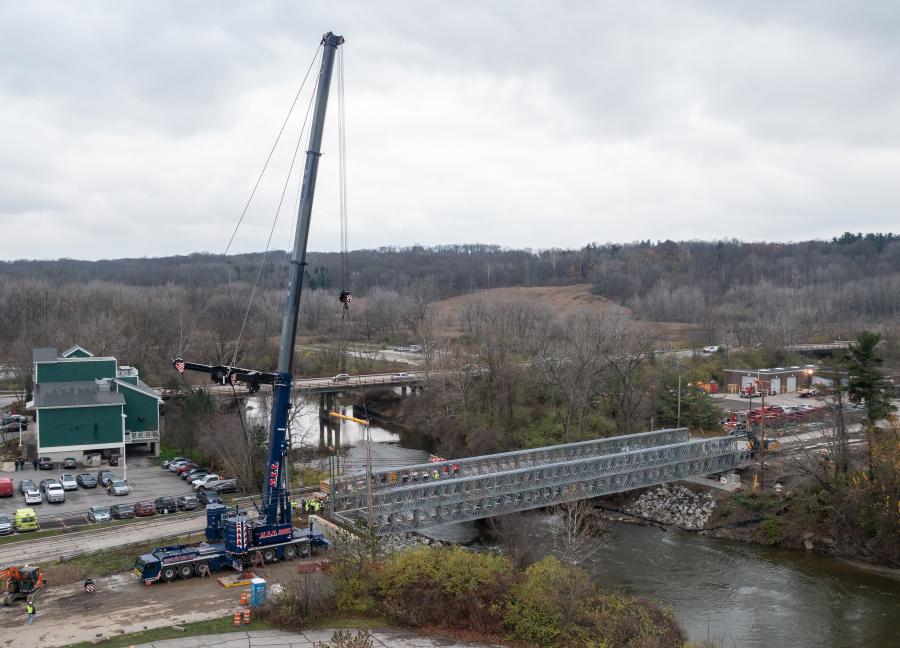
Wed February 8, 2023
ALL Crane
A roadway servicing the flagship yard of ALL Erection & Crane Rental was the site of some crane work of its own, as one of ALL's massive all-terrain cranes helped install a temporary bridge at the site.
The 40-acre yard is located in Independence, Ohio, just outside of Cleveland, and the Cuyahoga River runs through the site. Cuyahoga County recently began a replacement project for the bridge that spans the river, which will require the temporary bridge to be in place for approximately 18 months.
ALL used one of its own Liebherr LTM 1650-8.1 all-terrain cranes to assist general contractor Kenmore Construction in setting a 340-ton, 200-ft. Acrow temporary bridge.
Often used in military applications, these modular bridges are typically assembled on one side of a body of water then simply pushed or slid over to the other side by a bulldozer or other close-to-the-ground equipment. Site limitations prevented use of that method in this case. Instead, the crane was positioned on the east side of the span, reached across the waterway, and pulled the bridge into position.
An excavator on the west end fed the bridge, which was on heavy rollers, toward the crane.

"This was too long of a span, too heavy and at too high of an elevation to use the conventional method," said Brian Meek, sales representative of ALL. "The excavator could only push it halfway."
Meek credits the team at Kenmore Construction for planning and attention to detail, particularly the engineering work on the reaction chart.
"At first hook, the crane was only holding 1,000 pounds. But by the end, it was at 170,000 pounds," said Meek. "So, as you're booming toward the crane, you're gaining weight."
It created a unique scenario, as typical crane lifts require considering weight and capacity as the boom moves away from the crane.
"We needed a crane with a far reach, a lot of headroom for the rigging, and the ability to finish close with a minimum radius," said Meek.
Meek estimates he spent five or six hours plugging various cranes into his computer-simulated lift plan before he arrived at the perfect equipment for the job: the Liebherr LTM 1650-8.1. Its 770-ton capacity kept the bridge well within safe capacity percentages. Its 263-ft. boom length had plenty of reach (the lift needed only 170 ft. of boom).
"Although the boom length stayed the same for the entire lift, we needed the Liebherr Y-guying attachment due to the weight the crane took on about halfway through the lift," said Meek. "It was a heavier weight at a farther radius. It was the most critical range during the lift, so we added the attachment."
The excavator cantilevered the bridge past the west abutment. Once the bridge broke 100 ft., the crane started to take weight. Due to the precise planning and proper crane selection, the lift took just under an hour to accomplish.
For more information, call 800/232-4100 or visit www.allcrane.com.

 Cranes Equipment
Cranes Equipment Articles
Articles Email Updates
Email Updates Sell Your Machines
Sell Your Machines

 Cranes Equipment
Cranes Equipment Cranes Dealers
Cranes Dealers Cranes Articles
Cranes Articles Email Updates
Email Updates Sell Your Machines
Sell Your Machines